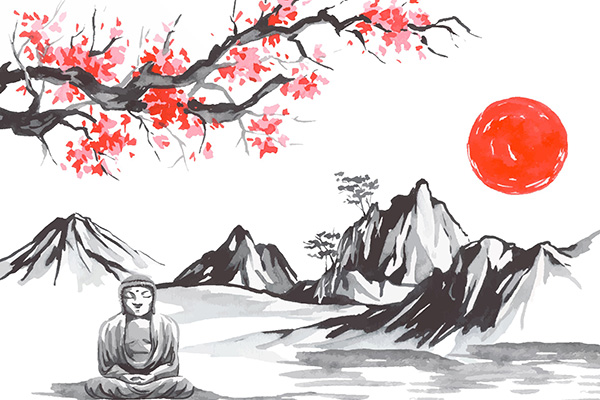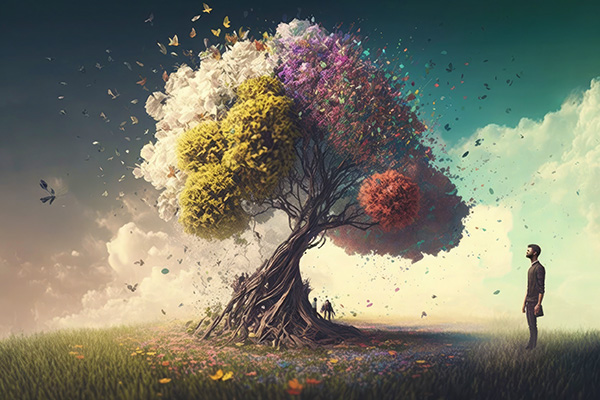life lessons
Always Feel Free To Own Your True Feelings
 Has anyone ever told you that you are too happy? Or has anyone ever told you that you smile too much? My guess is probably never.
Has anyone ever told you that you are too happy? Or has anyone ever told you that you smile too much? My guess is probably never.
So, why is it that whenever we experience negative emotions, be it grief, despair, or depression, we are often told that there is a time limit to such feelings and that we need to get over it. In today’s society, it is essentially also taboo to express feelings of loneliness, sadness, fear, or simply being unhappy.
My brother died at the tender age of 12 and left such a void in our lives that my entire family grieved his loss for decades. Fortunately, we were raised to accept this as a perfectly normal and natural process for us. We all understood that we would work through our feelings of grief and loss in our own way and at our own pace. We did not grieve according to a schedule or set of societal rules.
I find that a useful way to think about feelings and how to process them is to think of our emotions as being processed by our heart and mind like food is processed by our body. Just like food, we need to break down, digest, and assimilate the lessons and insights in our emotions to serve as growth “nutrients” for the soul.
The Divine Timing Of A Soulmate Connection
 A dear client I have been reading for many years called me the other day to finally confirm what I always knew was going to happen. As much as I was not shocked or even surprised, this event “blew her mind,” as she bluntly put it.
A dear client I have been reading for many years called me the other day to finally confirm what I always knew was going to happen. As much as I was not shocked or even surprised, this event “blew her mind,” as she bluntly put it.
You see, for years she had sworn up and down that she would “never, ever, ever in a million years” hear from her soulmate again, but now she has!
From my perspective, it was always just a matter of time. For years I told her not to lose faith and to hold on to the mystical love they shared because one day he would come back to her. But she kept shrugging and rolling her eyes and muttering things like “in my dreams” and “when pigs fly.” She just couldn’t accept the fact that he would one day be coming back into her life.
I must confess that while I was not surprised by this long-anticipated outcome, I was a bit intrigued by it for the simple reason that I thought for sure that her constant negative thoughts and feelings about the situation would eventually create so much energetic resistance that it would prevent her from reconnecting with him at all! But not even her constant self-sabotage and negativity could stop the turning of the wheels of destiny and divine timing. If we are meant to connect with someone who is our soulmate, it’s bound to happen one way or another, whether we trust the process or not.
The Meditative Art Of Sumi-e Painting
 As a spiritual advisor and artist, I’ve always been drawn to the ways in which art and spirituality intersect to offer pathways to deeper self-awareness and tranquility.
As a spiritual advisor and artist, I’ve always been drawn to the ways in which art and spirituality intersect to offer pathways to deeper self-awareness and tranquility.
One such path that has had a profound impact on my life is Sumi-e painting, also known as suibokuga or ‘ink wash painting.’ It is a traditional Japanese painting technique that uses black ink, typically in varying concentrations, to create brushstroke-based works of art.
Sumi-e is characterized by its minimalism, simplicity, and emphasis on capturing the essence or spirit of the subject rather than its literal representation.
Paintings often feature subjects such as landscapes, flowers, birds and other natural elements. Artists use various brush techniques to create different textures, tones, and depths using only black ink on absorbent paper or silk.
The art form has deep roots in Zen Buddhism, which emphasizes spontaneity, simplicity, and harmony with nature. Practitioners often meditate before painting to cultivate a clear and focused mind, which they believe enhances their ability to express the essence of the subject.
Sumi-e painting has had a significant influence on various art forms, including calligraphy and other East Asian brush painting styles. It continues to be practiced and appreciated for its timeless elegance and ability to evoke profound emotions with seemingly simple brush strokes.
The Wisdom Of Being Open To Psychic Guidance
 I’ve seen firsthand the transformative power of being open to the truth and the willingness to receive guidance in a psychic reading. I have also seen the opposite, and its sometimes devastating consequences.
I’ve seen firsthand the transformative power of being open to the truth and the willingness to receive guidance in a psychic reading. I have also seen the opposite, and its sometimes devastating consequences.
Every reading offers the potential for profound insight and growth, but sometimes people struggle to face the truth in the answers and guidance they receive.
One particular reading stands out in my memory as a poignant example.
Several years ago, a client came to me for a reading about a very challenging romantic relationship. With a troubled look and a sense of urgency, she asked her question:
“Will my relationship with my partner get better?”
As I tapped into the energies surrounding her situation, the answers that emerged were quite disturbing and definitely not what she had expected. The runes spoke of lies, deception, and deep-seated issues that did not bode well for her or the relationship. However, when I shared this message with her, she was not at all pleased. Instead she reacted with resentment and stubborn resistance.
“That’s not what I asked,” she insisted, her voice tinged with anxious frustration.
Embrace Life’s Turbulence With The Right Attitude
 With the many ups and downs we face in life, it is sometimes possible to feel euphoric one moment and utterly devastated the next. Yes, life is challenging at times. But Spirit says that our attitude makes all the difference.
With the many ups and downs we face in life, it is sometimes possible to feel euphoric one moment and utterly devastated the next. Yes, life is challenging at times. But Spirit says that our attitude makes all the difference.
Life’s emotional roller coaster is an inevitable part of the human experience. However, by choosing the right attitude, we can transform this journey into an opportunity for growth, learning, and profound spiritual awakening. If we choose the right attitude, it can soften the emotional roller coaster ride of life.
Our soul purpose requires that there be times of great happiness and deep sorrow, for it is through successes and hardships that we learn how to evolve spiritually.
But when we choose to trust the process and embrace our journey with the right attitude, it becomes much easier to deal with the stressful issues and demands of everyday life.
Our attitude toward life’s ups and downs plays a pivotal role in shaping our experiences. By adopting the right attitude, we can greatly reduce the emotional turbulence that accompanies life’s challenges. It’s like putting a cushion in the seat of a roller coaster – it doesn’t eliminate the dips and drops, but it does make the ride more bearable!
Why Some Souls Depart This Life Early
 In over 15 years of doing spiritual readings, I’ve had to deal with some very difficult questions from clients who have suffered extreme loss or trauma.
In over 15 years of doing spiritual readings, I’ve had to deal with some very difficult questions from clients who have suffered extreme loss or trauma.
One of the most heartbreaking, however, is making sense of the death of an infant, child, or young adult, sometimes after a cruel and very unpredictable death.
Grieving the death of a young person can bring up some of the most profound and challenging emotions. While it is never easy to address this kind of loss with grieving parents and relatives, Spirit has been consistent in its guidance over the years.
Although I have been spared the loss of someone so young in my own life, I am no stranger to it. I have supported many families in this regard over the years, both professionally and in my personal life.
The first time I realized how fragile life really is, was when I was only 12 years old. I was looking forward to the summer vacation from school. One of my classmates who lived down the street and her family had relatives visiting for the summer. Two of the visiting cousins were more or less our age, so I had a nice group of girl playmates for the season!
There was also the younger brother of the visiting cousins, who was only six years old. He was an adorable child with blond hair, bright blue eyes, and a freckled face full of mischief. He followed his two sisters, my girlfriend, and me wherever we went during those carefree days. I did not mind having him around and even encouraged the others to let him play hide-and-seek and many other childhood games with us.
A Christian Mystic’s Guide To Dealing With Pain
 Our search for the meaning of pain, hardship, and suffering is a profound and enduring human endeavor.
Our search for the meaning of pain, hardship, and suffering is a profound and enduring human endeavor.
Throughout history, our spiritual beliefs and religious teachings have helped us understand and find meaning in life’s challenges and painful experiences.
These interpretations provide comfort, guidance, and a sense of peace in the face of adversity as we learn that suffering has a purpose or can lead to spiritual growth, enlightenment, or a deeper connection with the divine.
Our spiritual quest to better understand pain is driven by a deep desire to make sense of life’s challenges and to discover how these difficult experiences fit into the larger tapestry of our existence.
Religions and spiritual wisdom traditions around the world offer different perspectives on pain and suffering, each with its own explanation for why these experiences occur and how they should be approached or understood.
These diverse perspectives all share certain common threads: that the origins of pain and suffering lie in the concept of duality; that there is meaning to be found in suffering; and that through faith, reflection, and spiritual practice we can transcend the pain caused by duality and connect with something greater than ourselves.